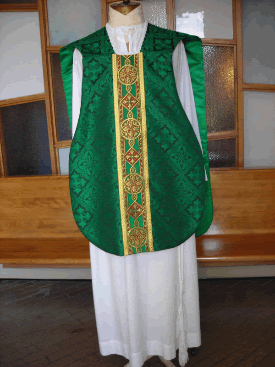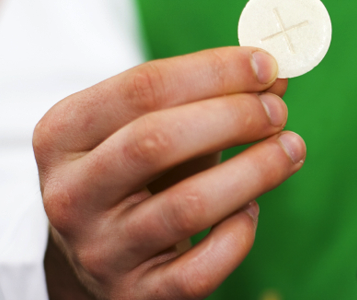Fewer priests, fewer Masses? Ask more questions
 With that whole election thing over (yeah, right), so I suddenly feel a need to turn to Something Completely Different. Thus, it's time to visit the tmatt folder of GetReligion guilt. Recently, the Newspaper That Lands in My Front Yard decided to take on a very important story. For years, mainstream coverage of the American Catholic Church has focused -- rightly so -- on the clergy sex abuse crisis. Meanwhile, in the background, people who care about the future of the Church of Rome have been able to hear the loudly ticking clock of another crisis.
With that whole election thing over (yeah, right), so I suddenly feel a need to turn to Something Completely Different. Thus, it's time to visit the tmatt folder of GetReligion guilt. Recently, the Newspaper That Lands in My Front Yard decided to take on a very important story. For years, mainstream coverage of the American Catholic Church has focused -- rightly so -- on the clergy sex abuse crisis. Meanwhile, in the background, people who care about the future of the Church of Rome have been able to hear the loudly ticking clock of another crisis.
The Baltimore Sun recently took a look at the declining number of Catholic priests, entering that giant subject through a perfectly logical door -- cutbacks in the number of Masses celebrated in parishes in the city and some of its suburbs. Here is the totally predictable, but still effective, lede:
With Father Patrick Carrion away, a nun led a morning service last week at St. Mary Star of the Sea, directing the gathering of 15 worshippers in Catholic hymns and prayers, and distributing the Communion that the priest had consecrated before leaving.
The pastor could not find another priest to fill in for him while he left his South Baltimore congregation to take a brief vacation. He returned in time to say four weekend Masses, but in the meantime left condensed daily worship services to Sister Victoria Staub.
This circumstance at one parish underscores the critical shortage of priests across the Archdiocese of Baltimore. In response, church leaders are asking its 153 parishes to evaluate Mass schedules and consider cutting back, particularly if similar services are offered nearby. In Baltimore alone, there are 50 parishes. Several within blocks of each other have identical Mass schedules and many services are lightly attended.
The elephant in the living room room, of course, is the basic, but astonishingly complex, question: Why is this happening?
As you would expect, the Sun story proposes an answer. In this case, it is an answer that seems to have resulted from actual interviews with Catholics in pews. The problem is that this answer is only one piece of a much larger puzzle. Ready? Here we go.
Nearly half of the archdiocese's 153 active priests will reach the retirement age of 70 within the next 15 years, and 17 are already eligible to retire, church officials said. If the trend continues, there may be fewer than 100 priests by 2025. ... While the number of American Catholics has remained fairly constant at about 22 percent of the population, the number of priests continues to decline, according to the Center for Applied Research in the Apostolate at Georgetown University.
"When the number of priests comes close to the number of parishes, the problem is approaching critical," said Mark Gray, senior research associate. "Unless there is a significant increase in ordinations, the shortage will only get worse."
Some scholars trace the decline in priestly vocations to the sweeping changes, including alterations to the Mass, that occurred in the church after Vatican II, a council of church leaders who worked on areas of religious concerns from 1962 to 1965.
Many Catholics found the changes difficult to accept and vocations to the religious life have fallen off ever since. Also, many men have been unwilling to dedicate their lives to the priesthood and its vows of celibacy and service.
Now stop and think about this for a moment.
If the reforms of the Second Vatican Council caused confusion and grief among some Catholics, leading to a decline in priestly vocations, wouldn't it be just as logical that the spirit of Vatican II would also cause a corresponding rise in vocations among those who welcomed and embraced the changes? Why haven't these progressive Catholics flocked to altars?
This is a question that is rarely asked. Answering it leads to many other questions, including questions about the actual teachings of Vatican II -- as opposed to the "spirit of Vatican II" that is often cited by dissenters. Some believe the church didn't change enough. Some believe the church changed too much. Some believe the changes were appropriate, but are being twisted in some parts of the church more than others. Some believe that the changes were appropriate, but that the vocations crisis is being affected more by other factors.
While researching the clergy-abuse crisis, I ran into a liberal priest -- the often quoted seminary leader Father Donald B. Cozzens (click here and here for samples) -- who repeatedly stressed another reality (a harsh reality that also affects Catholic school closings). That reality? Collapsing birth rates. Catholic mothers and fathers with four or five children are much more likely to welcome a child's decision to become a priest or a nun than parents who have one or, maybe, two.
 So, what parts of the church are growing in Baltimore and what parts are declining? What parishes are producing priests? What dioceses in the United States are producing more clergy than others? Those questions will often lead to this other painful question: Where are the young Catholics?
So, what parts of the church are growing in Baltimore and what parts are declining? What parishes are producing priests? What dioceses in the United States are producing more clergy than others? Those questions will often lead to this other painful question: Where are the young Catholics?
So is it just Vatican II? Is this crisis primarily linked to Vatican II?
I have this question for Catholics who read this blog (and others who want to chime in, with URLs pointing to additional information): What are the essential questions that must be asked by journalists who are attempting to write about the vocations crisis and the aging of the Catholic priesthood in America?
I must admit that I also wondered if some members of the Sun team had theories of their own about this story. Sure enough, a few days later, columnist Dan Rodricks weighed in with this, under the classic headline, "Not enough Catholic priests? End celibacy, ordain women." Here's a sample:
The answer to the priest shortage is the end to celibacy, the acknowledgment that it imposes an inhuman condition on those who are called to serve Catholic families as priests performing the sacraments. Celibacy once provided priests with what Garry Wills, author of "Why I Am a Catholic" and many other books, describes as a special aura -- "the prestige of holiness" -- grounded in the concept of sacrifice and abstinence. But celibacy eventually sent many good men out of the priesthood and constituted a barrier for others. It also left bishops with fewer priests and, among them, the misfits and deviants who moved from parish to parish, damaging thousands of children along the way.
I have acknowledged many times (each time I take up this subject) that the Roman Catholic Church is not a democracy. It's the ultimate top-down organization. The Mel Gibson Catholics, they of the Latin Mass and the repeal of Vatican II, always respond to calls for the end to celibacy and the opening of the priesthood to women with jerking knees -- to kick the heretics out -- followed by genuflection to the status quo. But the status quo is just drying up the church's lifeblood, its future leaders.
Their church is not a democracy, but Catholics who still care about this can do something about it. They can speak up. They can demand change. They can present their bishops with sensible solutions.
So, if the Catholic Church will flourish if and when it, well, embraces the strategies of the Episcopal Church.
That's an important opinion. That's a question that must be asked, one question out of many.
List. Discuss.